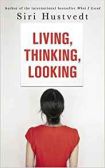Living, Thinking, Looking by Siri Hustvedt
| Living, Thinking, Looking by Siri Hustvedt | |
|
| |
| Category: Lifestyle | |
| Reviewer: Clare Reddaway | |
| Summary: An erudite, intellectual set of essays by intellectual novelist Siri Hustvedt. A challenging read, drawing on the sciences and the arts to analyse what it is to be human. | |
| Buy? Yes | Borrow? Yes |
| Pages: 400 | Date: June 2012 |
| Publisher: Sceptre | |
| ISBN: 978-1444732634 | |
|
| |
'Living, Thinking, Looking' is a collection of essays by Siri Hustvedt which, she claims, are linked by an abiding curiosity about what it means to be human. In these essays she examines who we are and how we got that way.
Siri Hustvedt is a highly intelligent, well-read and intellectual writer, as anyone who has read her novels will know. In her bestseller 'What I Loved' she explores human emotions through a compelling story, but she also offers an insightful critique of the New York art scene. She brings her learning to bear on whatever she is writing. So it was no surprise to see that she is frequently asked to write essays and articles for magazines and newspapers. What is startling is the range of institutions that she writes for – 'The Guardian', 'Granta', 'The Yale Review' and the 'New York Times' might be obvious, but the book also includes a lecture that is published in the journal 'Neuropsychoanalysis', a lecture given at the Prado and a catalogue essay for a Richard Allen retrospective at the San Diego Museum of Contemporary Art.
What is also unusual about these essays is the range of disciplines that Hustvedt is at ease with. As she remarks in one essay, the drive to specialise and the sheer volume of information that is now available on any topic, means that an eminent professor of one discipline knows nothing of another. Hustvedt however dips into psychoanalysis and neuroscience as easily as she references art history and literature. She writes seriously and thoughtfully about Proust in one essay, and Jaak Panksepp, a neuroscientist, in another. She manages to compare and contrast across science and the arts in a (fairly) accessible way. She is as at home commenting on a French philosopher who came to prominence in the 1980s as she is with introducing an undervalued Scandinavian novelist from the 1940s.
As a reader, these factors present an interesting conundrum. On the one hand, I long for a writer not to talk down to me, to present me with a wide variety of thoughts and conclusions, to startle and amaze me with their erudition. On the other, I want to understand what is being written and to retain some ideas and conclusions once I've finished a book. These essays approach their subjects with varying degrees of intellectual depth. The articles for the Guardian are more accessible than the one delivered as the thirty-ninth annual Sigmund Freud Lecture in Vienna. I found that particular essay ('Freud's Playground') hard. It was a great deal harder to read and understand than I expect to encounter in a non-specialist book of essays. Whereas her essay 'Notes on Seeing' was stimulating and interesting – and easy to understand.
Hustvedt's topics are also diverse. The essay 'My Strange Head: Notes on Migraine' was genuinely insightful and memorable. Her thoughts about the contemporary emphasis on whether a story is 'real' and how that equates to fiction (in 'The Real Story') is interesting, as are her thoughts on the nature of desire in 'Variations on Desire'. However, she perhaps writes most brilliantly on art. Her essay 'Why Goya?' is excellent. She draws on many sources to analyse Goya's enduring appeal, and she pulls the reader along with her. I liked her essay on Louise Bourgeois. I also enjoyed one of her shortest pieces 'Duccio di Buoninsegna at the Met', where she analyses one picture by Siennese artist Duccio, with great insight and perception. I will look at his art differently from now on.
There is no doubt that these essays are erudite and intellectual. They are also rather indigestible when read all together. The constant references to the works of philosophers, psychologists and neuroscientists made this reader feel that I was reading an academic text rather than a book of essays pitched at a generalist audience. The wide variety of bodies who originally commissioned the essays shows admirable versatility on the part of the author, but leads to a slightly patchy reading experience. Or, on the other hand, you could say that there is something for everyone in this book.
My overwhelming impression at the end of the book, and the one that I shall take away with me, is that Siri Hustvedt is very clever. And that I can't quite remember what it is that she wanted to say.
If this book appeals then you might also enjoy The Summer Without Men, also by Hustvedt.
Please share on: ![]() Facebook,
Facebook, ![]() Twitter and
Twitter and
![]() Instagram
Instagram
![]() You can read more book reviews or buy Living, Thinking, Looking by Siri Hustvedt at Amazon.co.uk Amazon currently charges £2.99 for standard delivery for orders under £20, over which delivery is free.
You can read more book reviews or buy Living, Thinking, Looking by Siri Hustvedt at Amazon.co.uk Amazon currently charges £2.99 for standard delivery for orders under £20, over which delivery is free.
![]() You can read more book reviews or buy Living, Thinking, Looking by Siri Hustvedt at Amazon.com.
You can read more book reviews or buy Living, Thinking, Looking by Siri Hustvedt at Amazon.com.
Comments
Like to comment on this review?
Just send us an email and we'll put the best up on the site.


